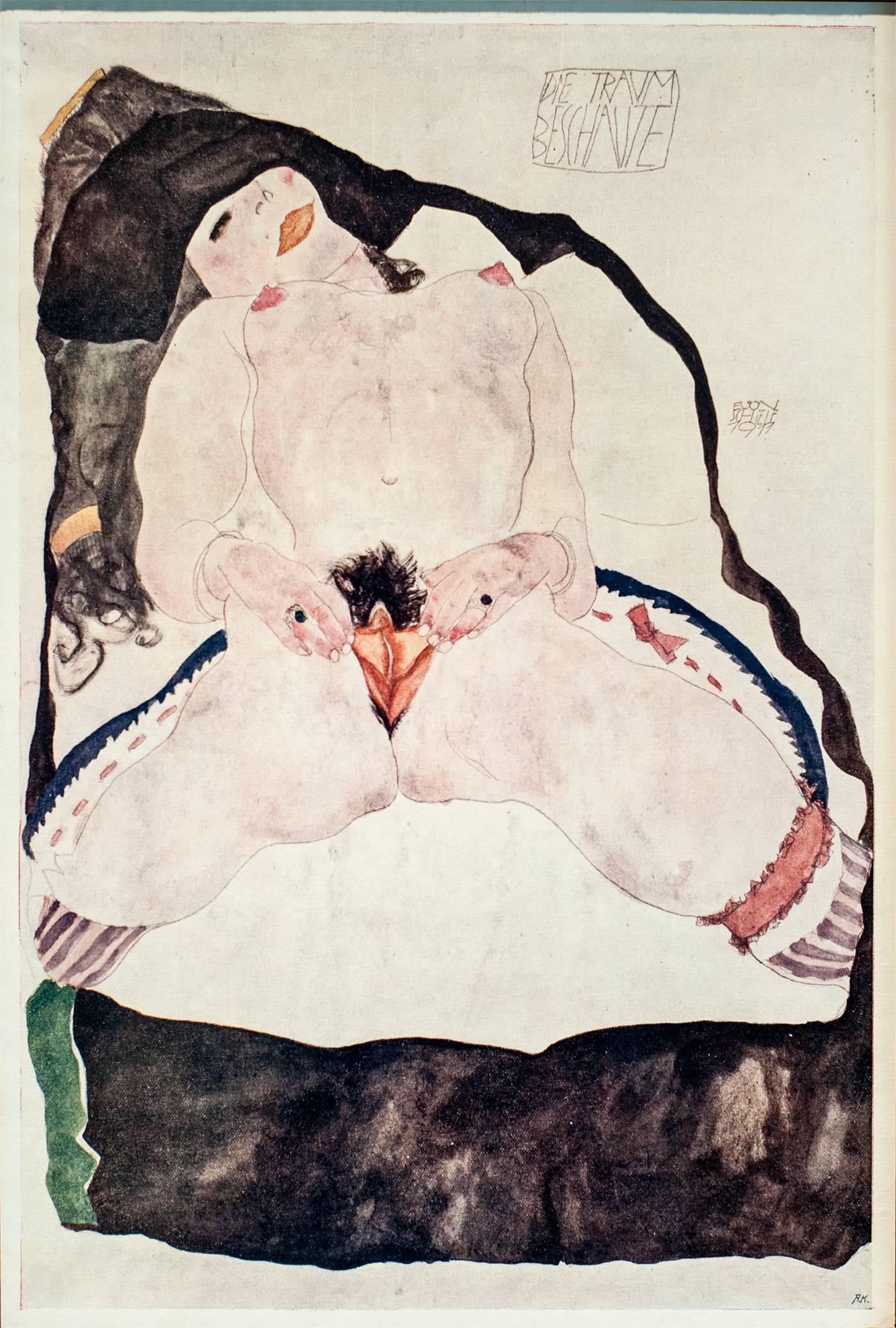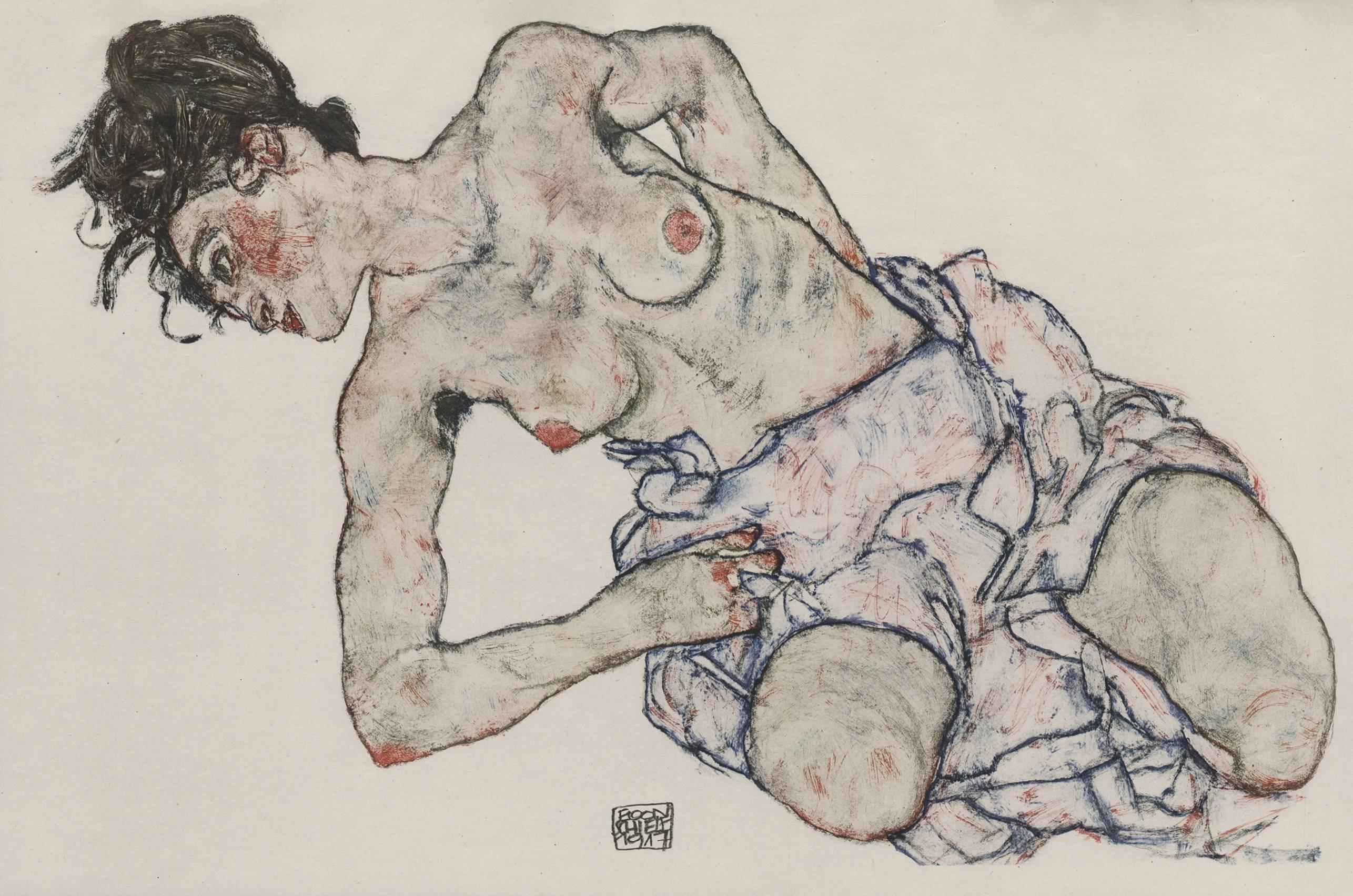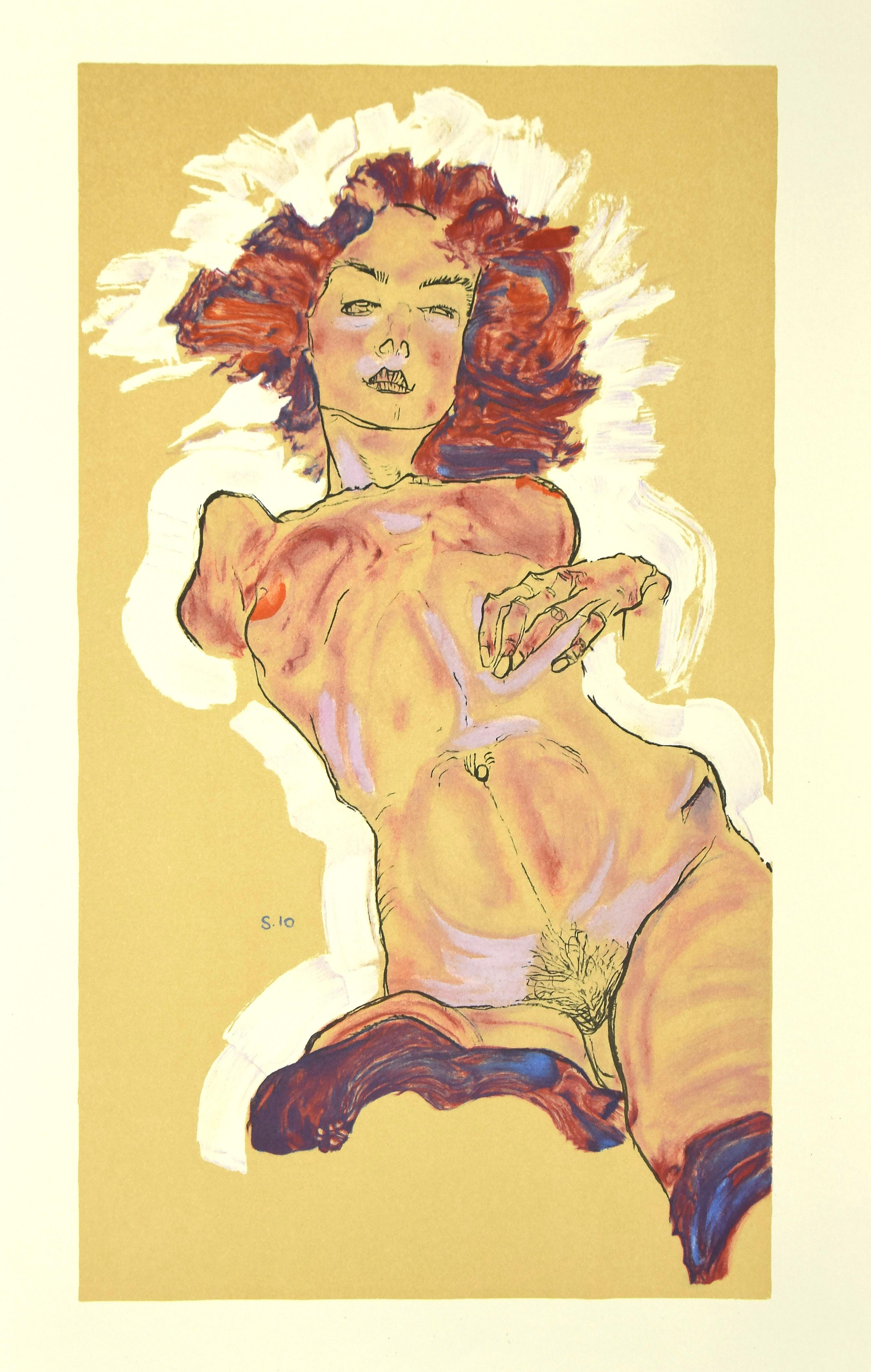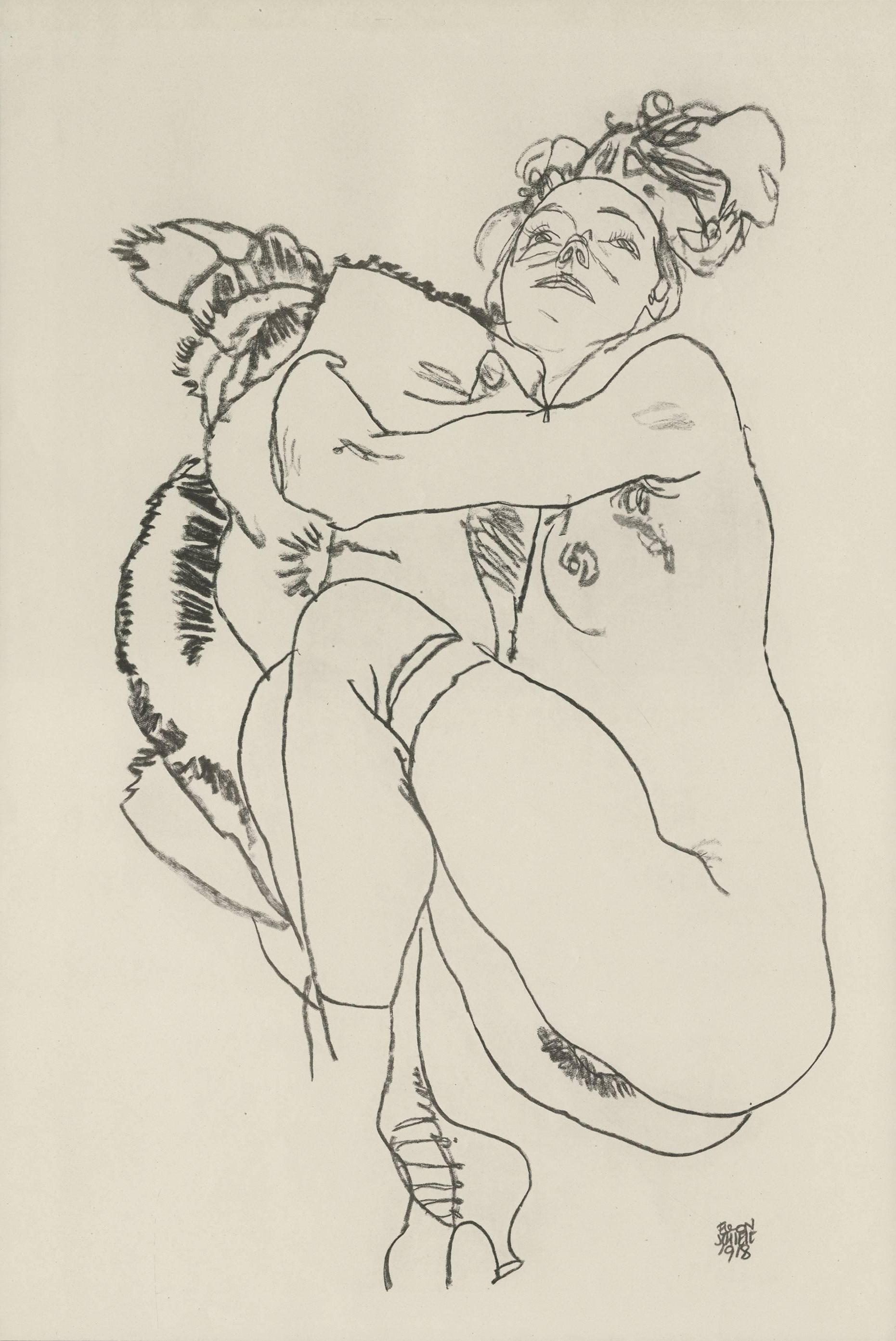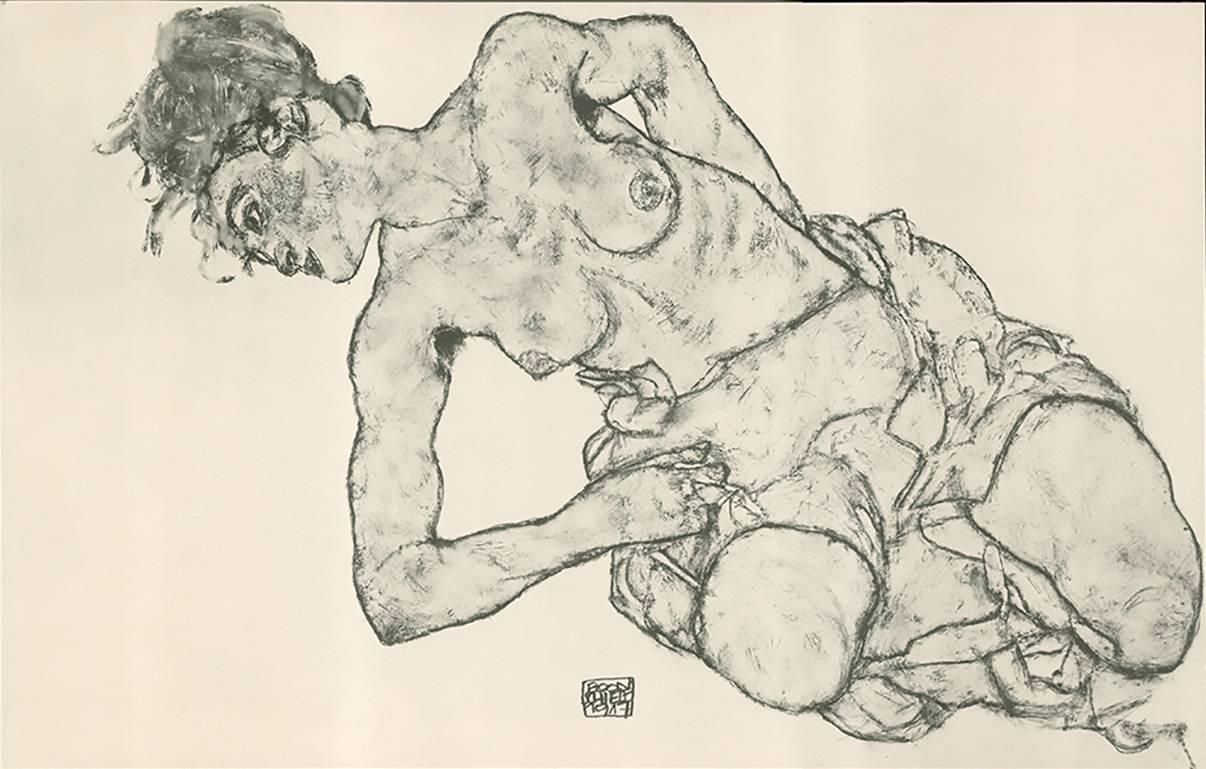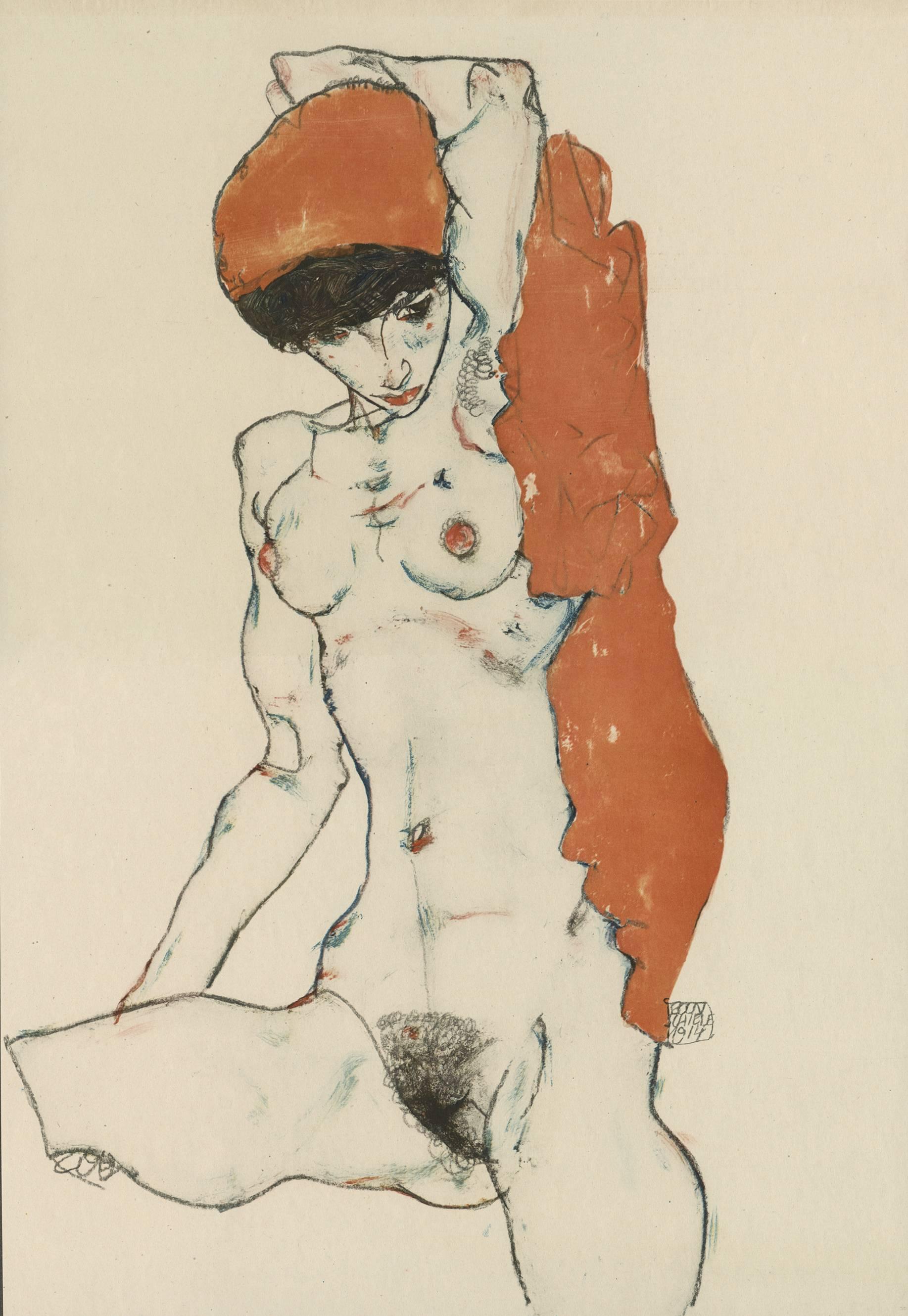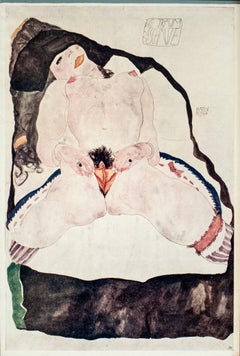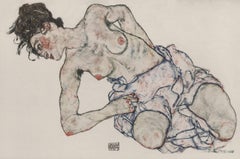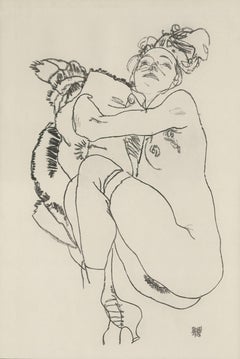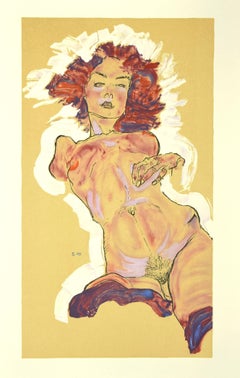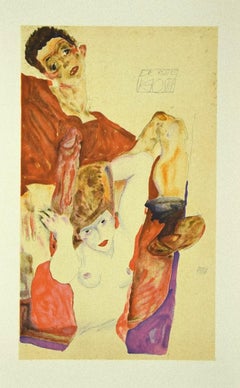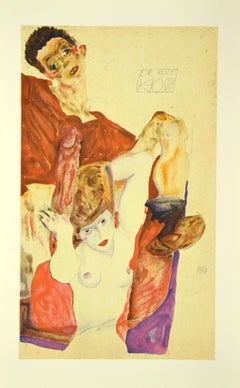Items Similar to Masturbating Woman Surrounded by Black
Want more images or videos?
Request additional images or videos from the seller
1 of 7
(after) Egon SchieleMasturbating Woman Surrounded by Blackc 1920
c 1920
$24,000
£18,265.92
€20,915.03
CA$34,136.14
A$37,396.90
CHF 19,535.41
MX$449,586.22
NOK 244,226.56
SEK 230,344.56
DKK 156,140.78
About the Item
Published anonymously c. 1920, Vienna, in an edition of 100, after the original gouache, watercolor and pencil on paper, signed and dated in the plate by the artist in middle right: “S. 10.”; printed in color and marked in the lower right by the printer: “AK.” who is believed to be Andreas Krampolek.
This work, its original watercolor purportedly now lost, relates to a series of works in pencil, watercolor and gouache which Schiele likely undertook upon his return to Vienna in the Fall of 1910. Having just spent the better part of five months in the small town of Krummau where Schiele had envisioned starting an artists’ colony, he had left there discouraged by the group dynamic but more committed than ever to devote his life to his work. Hereafter, Schiele would indulge his own curiosity and his own inclinations.The final months of 1910 were a turning point in Schiele’s art. His expressionistic style for which he has come to be known emerged at this time. In this rendering of a woman masturbating, Schiele rejects contextualization or the use of artistic conventions of beauty. Giving emphasis to sinewy limbs and taught musculature in the torso, Schiele conflates androgyneity with femininity. Hiding the left hand behind the back in a manner suggestive of being bound, the right hand is quite large and unnaturally dexterous. With thumb and fifth finger spanning from navel to the thigh, the middle fingers vigorously massage the vagina. Darkened finger tips indicate the application of pressure on fleshy body parts, and the effect of this friction is evident in the darkly depicted genitalia. Schiele had embarked on a life-long quest of exploring all aspects of human sexuality in an effort at coming to terms with his own psychological pathos. Viewing this image, one feels Schiele’s resolve to resist and overcome social obstacles. One senses Schiele’s determined spirit on a quest for autonomy and self-empowerment. Exploring an act of self-pleasure was, ultimately for Schiele, a means of gaining more self-awareness and knowledge about his inner self for his own sake.
As much as Schiele’s images cover bold territory, the portfolio itself has a colorful history all its own. It is one which involves censorship, destruction and trials about morality. Born out of the lofty ideas and ambitions of artists and art lovers, the portfolio represents state of the art printing in its day as well as art as interstate commerce. The erotic subject matter of Schiele’s five images included in the portfolio necessitated discretion. The portfolio printed in an edition of 100 was published anonymously. The one-time printing, as it states on the cover page, was only for subscribers. Thus, from the portfolio’s inception, there is an implication of secrecy and exclusivity. Even the printer’s contribution is cryptic. Save for the discreet initials inconsistently marked on each printed sheet, no mention is made about the printer, its whereabouts or even the year in which the portfolio was created.
Scholars now believe the printer to be Andreas Krampolek (1869-1940), a Viennese art printer specializing in the collotype process. Upon his 40th anniversary of printing in 1923, Krampolek’s work was honored with an exhibition at Vienna’s Museum of Art and Industry. That same year was also a critical one in the story of the portfolio. In September, Karl Grunwald was tried before the Regional Court for Criminal Affairs in Vienna. Accused of disseminating pornographic prints, Grunwald was charged with a violation of the law on moral grounds. The prints in question were none other than the EGON SCHIELE: FUNF ZEICHNUNGEN portfolio. Grunwald had sent this portfolio to Hans Goltz in Munich who was a former art dealer of Schiele. Grunwald offered Goltz 200 sheets, or the equivalent of 40 portfolios, for purchase. Goltz declined the offer and returned the portfolio of Schiele prints to Grunwald in Vienna. Customs authorities intercepted the package and brought charges against Grunwald. Although a jury found Grunwald to be Not Guilty of any crime, the 200 sheets from the portfolio did not fare as well. Attorney General Hofrat Formanek pushed for a separate hearing with the intention of destroyingg the 200 images. In a bold act of censorship which recalled a similar outcome in court during Schiele’s lifetime, the art prints were destroyed by the court authorities. By late-1923, only 60 portfolios remained.
Karl Grunwald and Egon Schiele had met one another several years prior during the war early in 1917. Leopold Liegler, one of Schiele’s art patrons, intervened on Schiele’s behalf in an effort to get Schiele transferred out of combat duty and back to Vienna where he could better focus on his art. Appealing to Grunwald’s sensitivity for and appreciation of the arts, Liegler suggested the Military Supply Depot in Vienna where Grunwald was stationed as an option for Schiele. Indeed, through Grunwald’s help, Schiele was transferred there on 12 January, 1917. In Grunwald, Schiele found a champion. Grunwald modeled for Schiele and befriended him. By the Spring, Schiele had hatched his ambitious plan for an artistic gathering place. Schiele’s Kunsthalle was to be a public forum where poets, painters, sculptors, architects and musicians could freely interact. Among his recruits were leading artists such as Vienna Secession founders, Gustav Klimt and Hans Hoffmann; the composer Arnold Schoenberg and art patrons Liegler and Grunwald. One of the key features Schiele enthusiastically envisioned for Kunsthalle’s commercial possibilities was to act as “its own art dealer and publisher.”
Schiele’s print portfolios were the sole fruits of this dream. Though Schiele’s Kunsthalle died on the vine, his portfolios effectively superseded the fixed art exhibition space to create a mobile concept. In 1917 bookseller Richard Lanyi published the first series of Schiele’s reproduction prints to much critical and commercial success. Following the war, Grunwald opened the gallery, Alte und Moderne Kunst in Vienna. He remained committed to Schiele, even after his untimely death in 1918, by staging an exhibition of Schiele’s work in 1921. It was only natural that Grunwald would continue Schiele’s commercial and artistic vision by publishing his own portfolio of Schiele works. FUNF ZEICHNUNGEN was Grunwald’s great contribution to Schiele scholarship. That some of the original 100 have survived is all the more significant because without this portfolio, the public today would not have a record of two key works by Schiele which, sadly, were lost during the Nazi era.
- Creator:(after) Egon Schiele (1890 - 1918, Austrian)
- Creation Year:c 1920
- Dimensions:Height: 19.69 in (50 cm)Width: 12.8 in (32.5 cm)
- Medium:
- Movement & Style:
- Period:
- Condition:See: "Egon Schiele: The Complete Works" by Jane Kallir. 1990. pg 413 (#572); Also, "The Naked Truth" by Tobias G. Natter, pg 241.
- Gallery Location:Chicago, IL
- Reference Number:1stDibs: LU46731809203
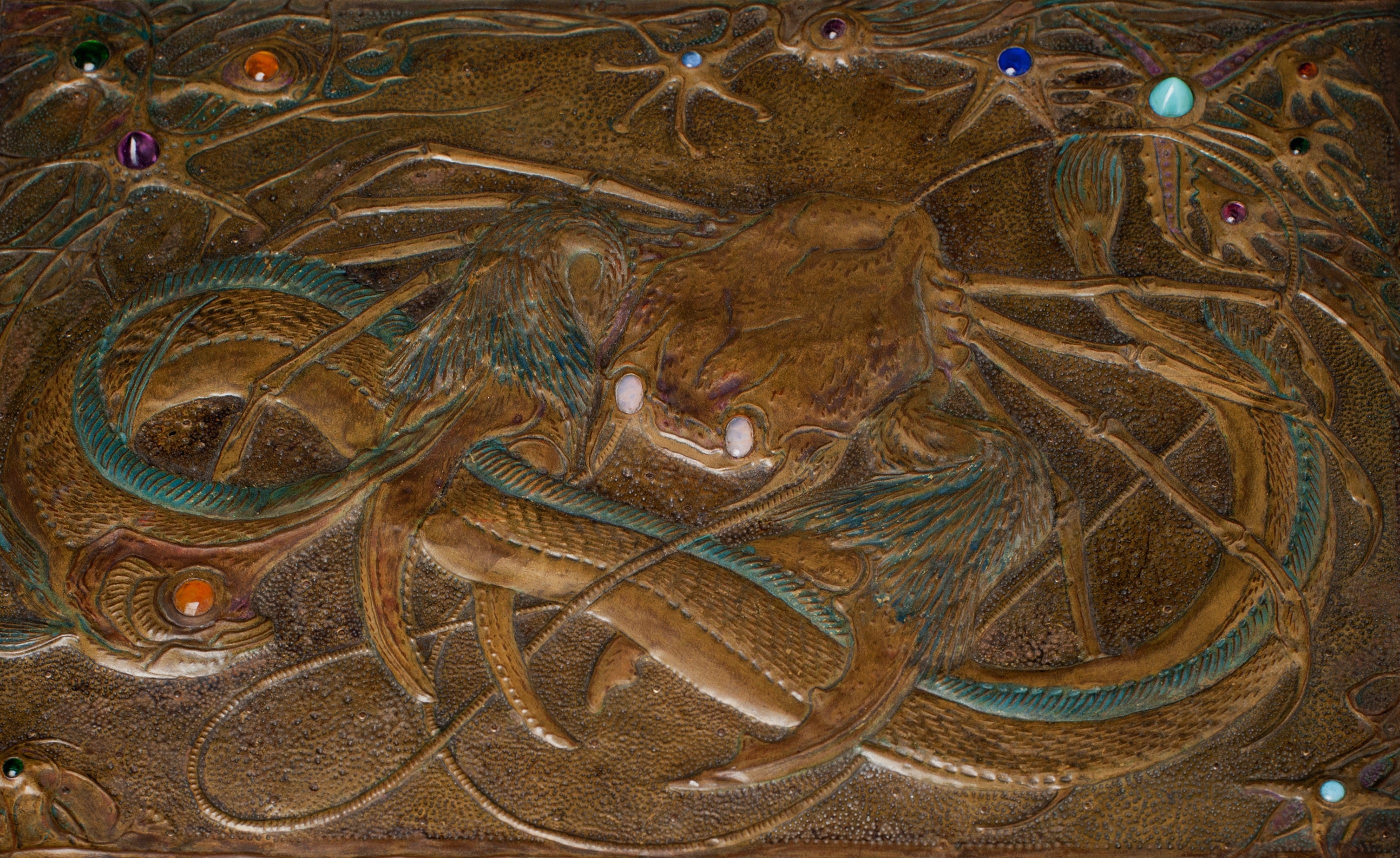
About the Seller
5.0
Gold Seller
Premium sellers maintaining a 4.3+ rating and 24-hour response times
Established in 2013
1stDibs seller since 2016
99 sales on 1stDibs
Typical response time: 6 hours
- ShippingRetrieving quote...Shipping from: Chicago, IL
- Return Policy
Authenticity Guarantee
In the unlikely event there’s an issue with an item’s authenticity, contact us within 1 year for a full refund. DetailsMoney-Back Guarantee
If your item is not as described, is damaged in transit, or does not arrive, contact us within 7 days for a full refund. Details24-Hour Cancellation
You have a 24-hour grace period in which to reconsider your purchase, with no questions asked.Vetted Professional Sellers
Our world-class sellers must adhere to strict standards for service and quality, maintaining the integrity of our listings.Price-Match Guarantee
If you find that a seller listed the same item for a lower price elsewhere, we’ll match it.Trusted Global Delivery
Our best-in-class carrier network provides specialized shipping options worldwide, including custom delivery.More From This Seller
View AllDIE TRAUME BESCHAUTE (OBSERVED IN A DREAM)
By (after) Egon Schiele
Located in Chicago, IL
Published anonymously c. 1920, Vienna, in an edition of 100, after the original watercolor and pencil on paper, titled in the plate at the top: “DIE TRAUM/BESCHAUTE” and signed and d...
Category
1920s Vienna Secession Figurative Prints
Materials
Paper
E. Strache, Handzeichnungen folio, "Kneeling Female, Semi-Nude" Collotype plate
By (after) Egon Schiele
Located in Chicago, IL
after Egon Schiele (1890 – 1918), AUSTRIA
“ART CANNOT BE MODERN, ART IS PRIMORDIALLY ETERNAL.” -SCHIELE
Defiantly iconoclastic in life and art, Egon Schiele is esteemed for his mas...
Category
1920s Vienna Secession Figurative Prints
Materials
Paper
E. Strache, Handzeichnungen folio, "Reclining Female Nude Glancing Up" Collotype
By (after) Egon Schiele
Located in Chicago, IL
after Egon Schiele (1890 – 1918), AUSTRIA
“ART CANNOT BE MODERN, ART IS PRIMORDIALLY ETERNAL.” -SCHIELE
Defiantly iconoclastic in life and art, Egon Schiele is esteemed for his mas...
Category
1920s Vienna Secession Figurative Prints
Materials
Paper
R. Layni, Zeichnungen folio, "Kneeling Female Semi-Nude" Collotype plate XII
Located in Chicago, IL
Egon Schiele (1890 – 1918), AUSTRIA
“ART CANNOT BE MODERN, ART IS PRIMORDIALLY ETERNAL.” -SCHIELE
Defiantly iconoclastic in life and art, Egon Schiele is esteemed for his masterful draftsmanship and precocious insight into the human condition. Part of the first wave of Austrian Modernism, he was swept away by the Viennese fascination with the tension between Life and Death (known in the works of Freud and his later interpreters as Eros and Thanatos). Life, identified with attraction, love, sexuality, and reproduction, and Death, represented by distortion, disease, repulsion, and hysteria, often appeared in the same composition, thereby suggesting the frightening life cycle of the human mind and body.
Young throughout his career, Schiele universalized his childhood traumas, thriving libido, insecurities, fears, and longings. His contorted line, jarring contrasts, and flat areas of color, demonstrate an early alliance with Expressionist philosophy and artists who were relentlessly frustrated by conventionality in all its forms. Schiele’s work embodied man’s disorientation and confusion in a seemingly absurd world, a world plagued by disease and war. It continues to be astonishingly relevant today, not just because it helped define Modernism but also because it revealed the dark and immutable aspects of the human condition.
Zeichnungen is a fine art print portfolio published by Verlag der Buchhandlung Richard Lanyi, Vienna, 1917, printed by Max Jaffe...
Category
1910s Vienna Secession Figurative Prints
Materials
Paper
E. Strache, Handzeichnungen, "Seated Female Nude w/Orange Drapery" Collotype
By (after) Egon Schiele
Located in Chicago, IL
“ART CANNOT BE MODERN, ART IS PRIMORDIALLY ETERNAL.” -SCHIELE
Defiantly iconoclastic in life and art, Egon Schiele is esteemed for his masterful draftsmanship and precocious insight...
Category
1920s Vienna Secession Figurative Prints
Materials
Paper
E. Strache, Handzeichnungen folio, "Crouching Female Nude" Collotype plate V
By (after) Egon Schiele
Located in Chicago, IL
Egon Schiele (1890 – 1918), AUSTRIA
“ART CANNOT BE MODERN, ART IS PRIMORDIALLY ETERNAL.” -SCHIELE
Defiantly iconoclastic in life and art, Egon Schiele is esteemed for his masterful...
Category
1920s Vienna Secession Figurative Prints
Materials
Paper
You May Also Like
Female Nude - 2000s - Original Lithograph After E. Schiele
By (after) Egon Schiele
Located in Roma, IT
Female Nude is an original colored lithograph from the portfolio "Erotica" by Egon Schiele.
It deals with a reproduction of the homonym artwork realized in gouache, watercolor, and ...
Category
Early 2000s Modern Nude Prints
Materials
Lithograph
Weiblicher Rückenakt - Original Lithograph after Egon Schiele
By (after) Egon Schiele
Located in Roma, IT
This lithograph from the portfolio "Egon Schiele" is a reproduction of "Weiblicher Rückenackt", an original artwork realized by Egon Schiele in 1917. The portfolio, that includes 10 ...
Category
1910s Modern Nude Prints
Materials
Lithograph
$895 Sale Price
25% Off
The Red Host - Lithograph after E. Schiele - 2007
By (after) Egon Schiele
Located in Roma, IT
The Red Host is an original colored lithograph from the portfolio "Erotica" by Egon Schiele.
It deals with a reproduction of the homonym artwork realized in watercolor and pencil by...
Category
Early 2000s Modern Nude Prints
Materials
Lithograph
The Red Host - Original Lithograph after Egon Schiele
By (after) Egon Schiele
Located in Roma, IT
The Red Host is an original colored lithograph from the portfolio "Erotica" by Egon Schiele.
It deals with a reproduction of the homonym artwork realized in watercolor and pencil by...
Category
Early 2000s Modern Nude Prints
Materials
Lithograph
Reclining Nude, Left Leg Raised - Original Lithograph After Egon Schiele
By (after) Egon Schiele
Located in Roma, IT
Reclining Nude, Left Leg Raised is a beautiful and original lithograph from the portfolio "Erotica" by Egon Schiele.
It is a reproduction of the homonym pencil drawing realized by t...
Category
Early 2000s Modern Nude Prints
Materials
Lithograph
The Red Host - Lithograph by Egon Schiele - 2007
By Egon Schiele
Located in Roma, IT
The Red Host is a colored lithograph from the portfolio " Erotica" by Egon Schiele.
It deals with a reproduction of the homonym artwork realized in watercolor and pencil by the Aus...
Category
Early 2000s Modern Portrait Prints
Materials
Lithograph
More Ways To Browse
Antique Massager
Lech Poster
Leonda Finke
Leonor Fini Sphinx
Leroy Neiman Artist Proof
Leroy Neiman Cafe
Leroy Neiman Football
Leroy Neiman Frank Sinatra Prints
Leroy Neiman Frank Sinatra
Leroy Neiman Sailing
Lichtenstein Art Critic
Linogravure Picasso
Luis Salazar
M Utrillo
Mabel Royds Woodcut
Magritte Etching
Magritte Le Retour
Mandela Hand Prints
